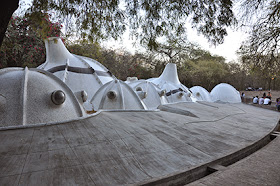Thurle and I met up with Lokesh and we visited the CEPT University Campus (Centre for Environmental Planning and Technology). As well as attending an exhibition of artwork by local schools we went to take a look at Doshi's 'Amdavad Ni Gufa'.
Designed by the architect B.V. Doshi (b.1927) and constructed between 1992 and 1995. The building incorporates elements of traditional or indigenous Indian housing in its use of materials and approaches to construction, insulation, and ventilation combined with complex structural considerations.
From the outside the building looks like a high tech observation hub (although I was also reminded of the beautifully 'fit for purpose' Barbapapa's New House).
At each end is a entrance hidden behind a brick facade incorporating steps,
The building is entered by going down a series of steps and passing through a porch like area with a large glass door and leaf like motif draw into the concrete floor.
You can clearly see the influence of Corbusier. Doshi worked as a senior designer in Corbusier's studio in Paris between 1951 -1954 and returned to India to manage projects in Ahmedabad and Chandigarh for Corbusier from 1955. In the same year Doshi also set up his own studio, Vastu Shilpa (Environmental Design). The Vastu Shilpa Foundation supports and promotes Doshi's values and approach to urban planning, architecture and design.
Born of a generation that saw India achieve independence and working at a time when the country was constructing a new independent nation, Doshi has come to be seen as one of the pioneers and leaders of contemporary Indian architecture.
Inspired by the work of Corbusier whom he described as his Guru, Doshi also took inspiration from traditional indigenous Indian Architecture, the Buddist caves of Ajanta and Ellora are said to have inspired elements of the design for the Gufa and many of his other works.
The building uses its subterranean position to control the temperature of the space, the earth acts as insulation and heat sink keeping it cool in the summer heat. The roof is a mosaic of white ceramic tiles, serving to reflect the heat of the sun.
Skylights allow light into the space and depending upon the position of the sun there are sometimes clear pools of light which move across the space whilst at other times the light is subtle and diffused.
I like the building a lot, although I get the sense that it is very much a prototype, a space that has been a platform for Doshi to play and explore, to test out some ideas both in the use of relatively unskilled labour to build it , the hand-built, low-tech approach to its construction combined with high tech structural analysis used to inform its design. It is atmospheric and intriguing, it appeals to the senses, but whilst it explores these touches, the ancient and modern technologies and how to bring these together, I am not sure how well it functions as a gallery space.
As well as the CEPT Campus and the Gufa, Doshi has also been responsible for NIFT - The National Institute of Fashion Technology in New Delhi, Sangath - the offices of his practice in Ahmedabad and The Indian Institute of Management in Bangalore.


























